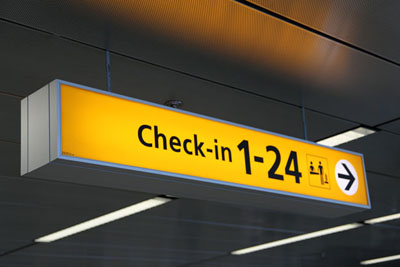In many countries photography of airports, security facilities, border posts, police and infrastructure of military significance is not allowed. If you want to photograph something that falls into one of these categories it is best to ask before doing so. Don’t be deceived by the apparent unimportance of a structure. Sensitivity to photography sometimes arises from an embarrassing lack of security or infrastructure.
 |
| Public domain image by Petr Kratochvil |
Airports are generally more difficult to negotiate than was the case years ago, mainly because of terrorism, so a high degree of personal organization is desirable. Try to minimize the number of separate items carried and have films (if used), passports, tickets and other documentation readily accessible. Many airports will not now allow containers holding more than 100ml of liquid in hand baggage, and only permit one item of hand baggage. When travelling alone, hand baggage and cameras cannot be left unattended and must therefore be taken to airport cafes and toilets with their owners. Bags on wheels, for both hand baggage and checked bags, are then particularly advantageous. Flight crews and cabin attendants use this system all the time. One final point is worth noting. Don’t return the keys of a rental car, if it is avoidable, until you are sure your flight is departing on time. It can be very useful when substantial delays occur.
It is important to remember, as you stand in yet another queue, that security checks exist to enhance passenger safety. A calm, polite approach to the process is the only sensible option – even in countries where security is obviously lax. In some countries metal detectors may not not be connected to the power supply, and items such as pen-knives may be confiscated, passed around the checks and then returned to the owner. Batteries may also be removed from photographic equipment and thrown in a bin. Officials at some airports then recover them for their own use.
Arrive at airport security checks in good time, even when all phootgraphic equipment is digital and no film is involved. The multitude of electronic devices, power supplies and connectors may some time to inspect. X-rays are not a problem with digital equipment, memory cards, disks or CDs. Metal detectors do not damage film or digital equipment. The high-dose CT (computerized tomography) scanners used for checked-in baggage will ruin most film in a single pass.
Carrying film makes things a little more complicated. Remove films from cameras before security checks if possible. Be prepared to wait until the officials are not too busy, when they may be willing to hand inspect any films. Some airports and officials will not allow on to an aircraft anything that has not been x-rayed. The options are then to put everything through the machine or not travel. Others will agree to a hand inspection, particularly if the process is made as convenient as possible. Film speeds up to 200 ISO are generally unaffected by a few passes through x-ray scanners provided the machines are modern and properly calibrated. Unfortunately this is not always the case in some parts of the world. Plastic APS film cassettes and roll films are less tolerant of x-rays than 35mm films housed in metal cassettes. If you are carrying film, have a quick look at the facilities and make you best guess. Then adopt a flexible approach aimed at minimizing the cumulative damage caused by exposure to x-rays. Ask for a hand inspection, particularly for film speeds of 400 ISO and faster. Films carried in lead-lined bags have some protection but also inherent problems. When hand inspection is refused they are passed through the machine safely, but then hand-inspected because the security staff were unable to see through the bags. Alternatively, the power of the x-ray machine may be increased in an attempt to see the contents of the bag. Carrying numerous batteries may also arouse some suspicion. One way around this is to explain why they are needed and suggest that the batteries are passed by security to a member of the cabin crew for the duration of the flight. This may work at smaller airports.
On large jets, the most comfortable ride is in the front or middle section of the passenger cabin. The rear part of the cabin is more susceptible to turbulence. On long flights this can make a significant difference to the ability to sleep. However, sitting at the rear has the advantage that you may be boarded early when the overhead baggage lockers are largely empty. On smaller aircraft space for hand baggage is more restricted. When permitted to do so, use the space under your seat which is usually sufficient for a medium-sized camera bag. Light aircraft have very little cabin storage space, so photographic equipment may have to be held on your lap or placed in a locker at the rear of the plane.






